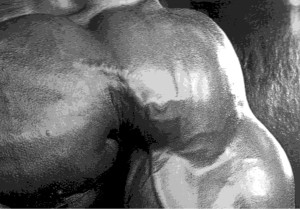
Well-rounded and capped off delts are one of the main things all guys seek to develop. Who doesn’t want them? They symbolize power and stature and are nearly always visible. You can cover up your chest and arms, but powerful, wide, sculpted shoulders appear even through clothes.
Let’s get into two common mistakes and the simple solutions that’ll get you back on track to building cannon ball delts.
The two common problems with conventional shoulder training are:
1) No rotator cuff work.
2) Going heavy only on pressing movements.
Problem 1: No Rotator Cuff training
Let’s get into the first problem. Neglecting the rotator cuff is a major issue that virtually all trainers make nowadays. Rotator cuff strains and tears are so common today, it’s not even funny.
Having a strong rotator cuff is critical when it comes to maintaining healthy, injury and pain free shoulders. It’s also incredibly important from a postural aspect.
Take a look at the function of the rotator cuff. It’s there to support and stabilise the shoulders. Without them, your shoulders would just sag forward.
Many people nowadays have shoulders that tend to slump forwards. This is due to internal rotation at the shoulder joint. The situation isn’t helped by training body parts such as the chest, which when over developed tends to pull the shoulders forwards and down. Further stressing the rotator cuff. This is a one way ticket to injuryville. Obviously, the solution isn’t to stop training the chest. That’s a stupid suggestion. Treat it like an equation. To maintain the balance, if you focus heavily on training your front, do the same for your back.
To avoid a torn or strained rotator cuff, devote a little bit of time to strengthening the muscles and tendons. If you don’t add any injury preventative work for your rotator cuff into your routine, you’re risking a potential injury in the long-run. Maybe it’ll happen, maybe it won’t. Do you really want to find out though?
Remember, injured shoulders will make virtually every upper body exercise a pain in the ass to perform. (I should say, pain in the shoulder).
Problem 2: Going heavy only on pressing movements
This is another common problem. You see it all the time. People have the right idea when it comes to presses. Whenever it comes to a movement like overhead presses people intuitively know what to do. They know instinctlily use as heavy weight they can to perform a given number of reps. But when it comes to the medial (side) head of the deltoid they forget all about it and treat it differently. They perform lateral raises with light weights to “get more of a pump.” It’s understandable in some ways because you’re obviously stronger and can lift more weight overhead on presses than out to the side with lateral raises.
The lateral raise is never going to be identified as a strength movement, at least not when compared to the overhead shoulder press. However, people tend to think of them as a light move and only ever work them in higher rep ranges. While that’s not necessarily a problem itself, it becomes a problem when you’re stuck to same weight and same rep range all the time.
People always bark on about progressive overload, yet when it comes to lateral raises people usually stick to lighter weight and never seem to shift.
Newsflash! if you want your delts to grow you’ll inevitably have to add more poundage.
The way I incorporate heavy side delt work into my training is through cheat laterals. Cheat laterals are just lateral raises performed with heavier weight. The form is slightly looser than when performing a strict lateral raise, however, the motion is still controlled. Under no circumstances do you allow your arm to swing all over the place. So if you normally do laterals with 20-25lb dumbbells, you’d use 50lb dumbbells.
Pick a weight you’d normally not be able to do many reps with. Use a slight bit of momentum to get the weight up and to the side and resist it as much as humanly possible on the way down. I usually perform 3 sets of 8 reps with each arm.
It’s worth mentioning, you should do cheat laterals one arm at a time, using your free arm to grab onto something to help support you.
This isn’t your regular, run of the mill lateral raise and I don’t recommend doing them all the time. Once every 2-3 weeks replace the regular lateral raise in your routine with them.
Let me know how or if you plan to incorporate the above into your training. Leave a comment below and subscribe if you like this article and want more.
For more useful in-depth content like this and more, grab a copy of WARRIOR 101. Hurry, the special offer ends January 1st 2014.
Don’t miss out on great and exclusive content. Not found anywhere else. Take advantage of the special festive offer and grab it today.
Great informative article. Really useful tips for the shoulders. You said it. The rotator cuff doesn’t get the attention it truly deserves.
BTW I grabbed my copy of WARRIOR 101, taking my time reading over the content as we speak. Amazing in-depth info inside it. You’ve really put a lot of effort into it. It’s easy to follow as well. In two words “SIMPLY AWESOME.” IT’S A DAMN MASTERPIECE.
Those that haven’t got a copy yet are missing out on great info. 101 pages of it.
Yep, the rotator cuff is neglected alright. There’s more damage done by not spending some time strengthening it.
Great to hear you’re loving WARRIOR 101. If you need any help with anything, you know who to call.